Glue ‘n’ paint
This week: Glue ‘n’ paint; Let assembly begin; An excess of peaches; The Felines;
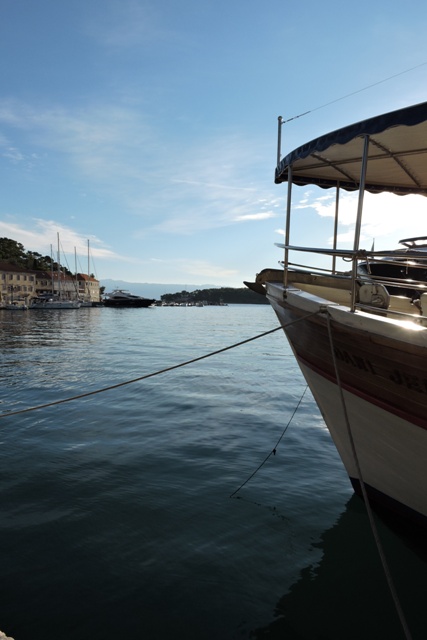
The number of COVID-19 cases in Dalmatia continues to increase. Like many countries, it is generally amongst the 18 – 45 age group.
Hospital admissions are also increasing, but deaths have yet to start catching up. The emergency planning authority continues to increase the restrictions, reducing the number of people who can meet, the opening times of bars and for the wearing of masks.
There was a moment of political honesty at the weekend. President Zoran Milanović and Slovenian President Borut Pahor were on the island of Rab for the 77th commemoration of the liberation of inmates from the WWII Kampor fascist concentration camp.
On Saturday when asked if he and President Pahor talked about the reopening of borders given that Slovenia has put Croatia on the red list of COVID countries, President Milanović commented that there was a reason why Slovenia had done so.
“The number of daily Croatian cases of infections increased because almost a million foreigners arrived in Croatia in July and August so that we could make money. That’s not surprising.”
“That’s the price we consciously paid both as a state and as a society, and we should finally accept that…”
“Let’s not be surprised that almost a million foreigners passed through Croatia, leaving their money here, socialising, forming crowds, and that some got infected. But that’s the price of the risk we were all willing to take. Slovenia’s reaction was expected, that will change.”
Although I really need to go to Split, I really do not want to take my chance on the ferry while social distancing and mask wearing is routinely ignored and while there are still a lot of people.
Glue ‘n’ paint
I finished the assembly of the first louvre for my new Stevenson Screen this week.
That was easy to say, but more difficult in practice and the construction has been very time consuming.
Do it once and do it right is my mantra. That means tasks take longer than planned, because I go the extra mile, whether that be in preparation, painting or construction.
When I looked on line for a ready made Stevenson Screen, they were in the €2,000 to €2,500 bracket. This was a price I found difficult to believe, that was until I started doing my own construction.
What I practice is advanced DiY – DiY which is beyond the scope of many in the DiY fraternity.
I have the power tools which are appropriate both for my level of expertise and for my needs, so things like the Makita Planer/Thicknesser gets frequent use taking locally supplied raw timber and turning it into PSE carpenter grade wood.

It is not the sort of wood working tool that many people would have, mainly because in most countries you can actually obtain the PSE timber you need, but not here.
The electric mortising machine is another useful tool, albeit one which does not get a great deal of use.
None of these are capable of being computer controlled. I do have a small engineers lathe which is capable of being CNC computer controlled but I didn’t buy the expensive module, until I decided if I would use it. I’ve not needed it so far.
Factories and larger workshops now have CNC machines to automate most processes, increasing the accuracy of the pieces being produced, making things quicker and so more cheaply.
They have some quite exotic names, things like Plasma Cutters (straight out of Star Trek), Sinker EDM cutters and Turret Punches, which house up to 60 different tools in one machine turret (I want one!).
I’ve cut quite a lot of rough seasoned timber from my supply this week.

After cutting roughly to size, I run pieces through the Thicknesser, to create lengths of exactly the same dimensions. Finally I then measured and cut pieces by hand to create the parts I need.

All the timber has had two coats of primer/undercoat followed by a coat of Hempalin external gloss paint.
The parts have been painted before cutting, because I find it is a lot easier to paint a few long lengths that lots of short lengths.

Even achieving two coats of paint in 24 hours has meant that it has been time consuming, especially where all four sides of a length of timber require painting.
Because I am using a wood glue for construction, in some instances one side has been left as bare wood, so the joints are glued bare wood to bare wood.
Let assembly begin
Having cut everything by hand, the accuracy is to within 1 mm, which is the thickness of the saw blade.
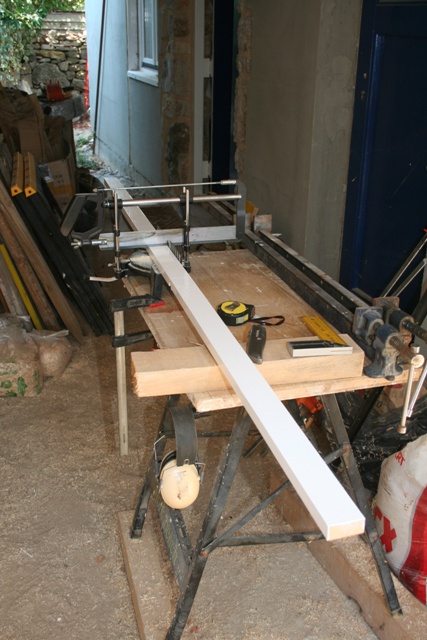
It took a little while to work out what was going to be the best angle for the louvres, to allow air to flow into the Stevenson Screen, but at the same time to prevent precipitation ingress. I eventually settled on 40º degrees.
l cut large numbers of wedges, which I then carefully drilled to take panel pins, and also glued into place on the vertical carriers.
The fit of the wooden louvres is tight, just so a mallet is needed to knock them into place.

After leaving the carriers to let the glue dry for 24 hours, I started assembly, first one at a time, then glueing three louvres in place at the same time. This is the smallest of the four outside frames, but it still has 16 louvres.
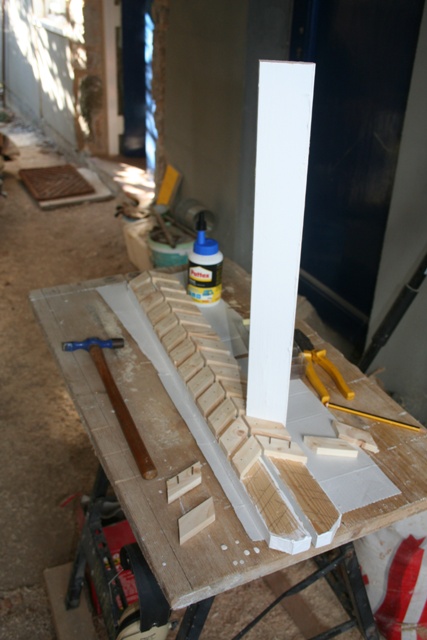
When I counted up the number of component parts, there are 50, plus the pins, to make this single frame.
With one side completed, I used a 10 mm brush to paint white wood glue between each wedge on the other carrier and quickly started at one end to slide the louvres into place. I needed my large frame clamps and some heavy timber fences to tighten all the louvres into the reveals.
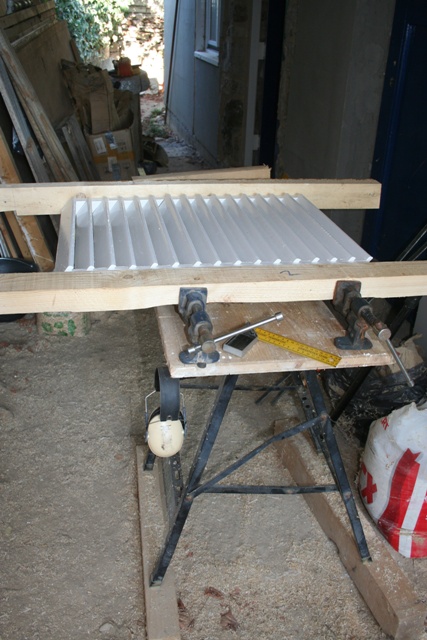
I had to make a couple of slight adjustments with the mallet before all the louvres were exactly in line. The whole thing was left in the frame clamps for 24 hours to allow the glue to set.
A check with the square and a level showed that all the joints were at 90º and all the louvers were precisely in line. Everything was square and true.
The final job was to offer the louvre frame up to the screen and fix it in place with 80 x 4 mm wood screws.

It does look nice, however I have to build another seven frames. Three are for the inside to act as baffles for air moving through the louvres.
Two more are for the two sides and the fourth is the door, which will combine both sets of louvres.
Having completed just the first part of the project, I can now see why the commercial screens are so expensive. However the materials they use are different.
Thermoplastic is used for the louvres and with CNC machines, the processes of cutting are speedy, automatic and far more accurate than I can achieve.
There is still a lot of labour involved in assembly, even where they are using a system of jigs to speed up the work.
My Stevenson Screen is being built to last, especially in the harsh environment of the hot Mediterranean summers that we have in Dol.
It will require a lick of paint every couple of years, but I am hoping that by properly preparing and protecting the timber, I will not have any problems with boring insects or rot. Time will of course tell….
Now I need more wood for the louvres, but when I went to Volat they were out of stock and have had to order it for me.
An excess of peaches
It’s the end of the season for almost all locally grown soft fruits.
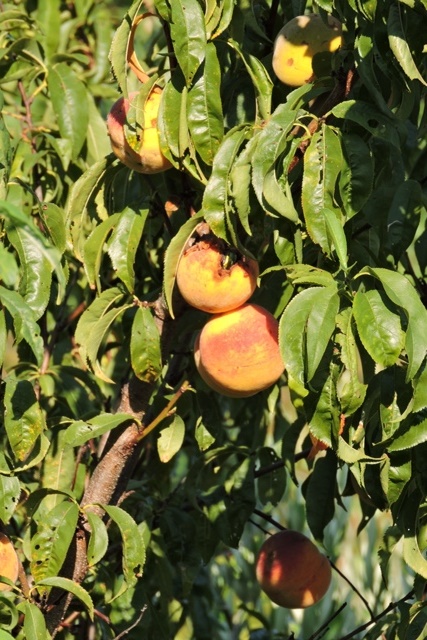
I have picked and eaten the last of the figs from my tree. I have one, single apple on the large apple tree in the top orchard. All my cordon trees have finished fruiting.
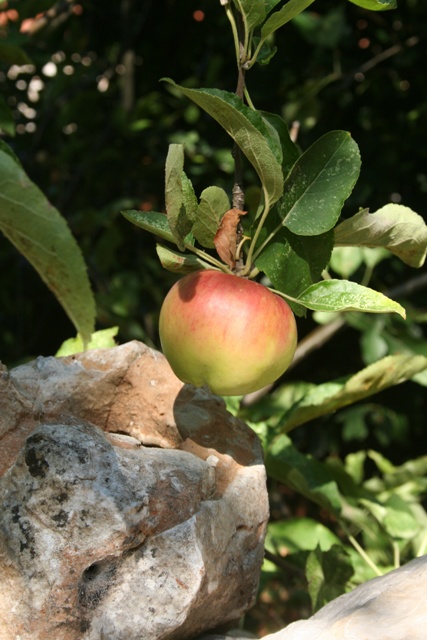
So until the citrus ripen, and the Pomegranates, which will be from the end of next month, I will have to make do with peaches.
I have picked all the remaining peaches. They look nice on the tree, but even nicer on the breakfast bar, waiting to be turned into a Peach Cobbler.
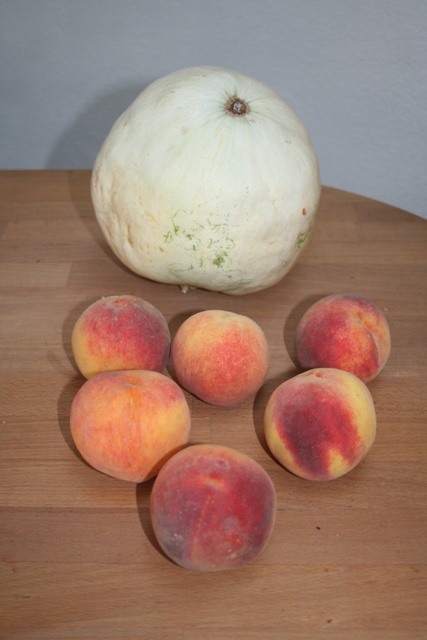
Behind them is a Squash, also waiting to be turned into something sweet.
The Felines
I’ve been to the Vets this week with Risha for his monthly injection of Depo-Medrol.

It is his birthday on Tuesday, when he will be 14 – so over 70 in human years. He is a rescue cat from Feline Friends in Abu Dhabi and I got him when he was just 3 months old.
He’s not been himself for the last three months, going off his food, being listless and generally under the weather.
The Vet thinks it is a tooth problem and certainly he seems to like soft food with lots of gravy, only not today. After the vets I called at the supermarket and bought some chicken, then cooked it, fed it through the mincer and offered it to him.
He just sniffed and walked away. The only time he has ever jumped up onto a kitchen worktop was when I was preparing chicken, so I know he is not feeling too good.
We are going to try this treatment for another month and then will look at surgery to remove his teeth. Before that the Vet wants to take a blood sample and sent it to Split for analysis for organ functions as he is concerned he might not survive a general anesthetic.
Meanwhile the kittens are now 8 weeks old and are into everything. At this minute Argent is asleep next to me on the desk.

Pongo is asleep in an Amazon box.
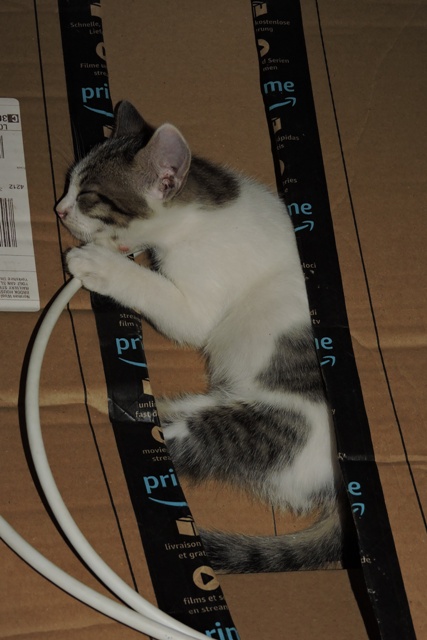
Tigger is asleep on a cardboard box and the two girls, Bjesac and Zavo, are asleep together on a cushion.
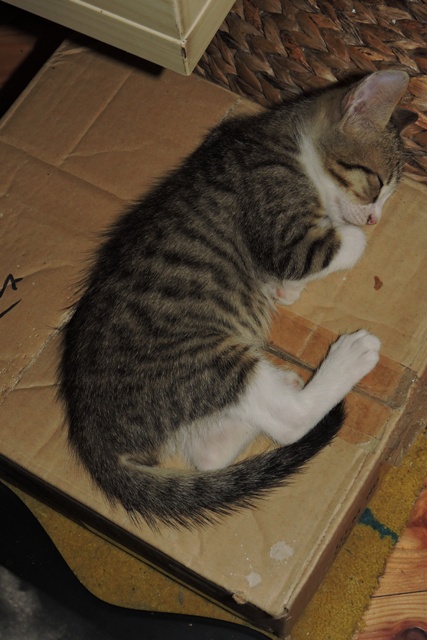

It’s definitely a cats life!
Gizmo, who is around the same age as their Mum seems to like having them around. He is playing with them and being a good Uncle. Risha acts like an indulgent Grandfather, it is just my middle cat, Callie, who is less than impressed with the little bundles of fur…
I’ve booked their Mum Isabijela, in for sterilisation on the 21st. The kittens have been eating solid food for some weeks now and I really don’t want any more litters.
The next job is find them forever homes. NRC
One Response
Richard Ellis
Do you rough sand the unpainted side (that gets glued) so you can achieve a subsurface bonding from the glue?
Any fine mesh screen on the inside of the louvers, to keep the bees and other small critters, from building nests inside?
Rick